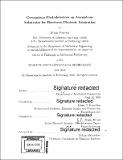| dc.contributor.advisor | Lionel C. Kimerling and Jurgen Michel. | en_US |
| dc.contributor.author | Pearson, Brian (Brian Sung-Il) | en_US |
| dc.contributor.other | Massachusetts Institute of Technology. Department of Mechanical Engineering. | en_US |
| dc.date.accessioned | 2016-09-13T19:14:27Z | |
| dc.date.available | 2016-09-13T19:14:27Z | |
| dc.date.copyright | 2016 | en_US |
| dc.date.issued | 2016 | en_US |
| dc.identifier.uri | http://hdl.handle.net/1721.1/104224 | |
| dc.description | Thesis: Ph. D., Massachusetts Institute of Technology, Department of Mechanical Engineering, 2016. | en_US |
| dc.description | Cataloged from PDF version of thesis. | en_US |
| dc.description | Includes bibliographical references (pages 197-208). | en_US |
| dc.description.abstract | Silicon photonics has emerged as a leading technology to overcome the bandwidth and energy efficiency bottlenecks of standard metal interconnects. Integration of photonics in the back-end-of-line (BEOL) of a standard CMOS process enables the advantages of optical interconnects while benefiting from the low cost of monolithic integration. However, processing in the BEOL requires device fabrication on amorphous substrates, and constrains processing to <450C. In this thesis, a germanium photodetector is fabricated while adhering to these processing constraints in order to demonstrate a proof of concept for BEOL integration. In order to obtain high quality active material, crystalline Ge was grown on Si0 2 by implementing selective deposition in geometrically confined channels. The emerging Ge grains were coalesced to fill a lithographically defined trench, forming the active area of a photodetector. The Ge was measured to have a significant tensile strain of 0.5 %, which was caused by thermal expansion mismatch with the substrate, and concentrated by small voids from imperfect coalescence. The associated resolved shear stress was determined to be below the critical resolved shear stress, verifying that dislocation generation does not occur in this material. The strain was shown to increase the absorption of Ge at long wavelengths, allowing for implementation along the entire telecom window. A Schottky barrier to p-type Ge was developed by the addition of a 1 nm tunneling A120 3 layer between an Al/Ge metal contact. This successfully de-pinned the Fermi level, creating a barrier height of 0.46 eV. The Schottky contacts enabled the fabrication of metal-semiconductor-metal (MSM) photodetectors on standard epitaxial Ge with state-of-the-art dark current densities of 2.1 x 10-2 A cm-2. Gain was observed in these photodetectors, with internal quantum efficiencies (IQE) of 405 %. MSM detectors were also made using Ge on Si0 2, exhibiting an IQE of 370 %. This is the first demonstration of IQE >100% in a Ge MSM or pin photodetector and proves the feasibility of making high performance active photonic devices while adhering to BEOL processing constraints. | en_US |
| dc.description.statementofresponsibility | by Brian Pearson. | en_US |
| dc.format.extent | 208 pages | en_US |
| dc.language.iso | eng | en_US |
| dc.publisher | Massachusetts Institute of Technology | en_US |
| dc.rights | M.I.T. theses are protected by copyright. They may be viewed from this source for any purpose, but reproduction or distribution in any format is prohibited without written permission. See provided URL for inquiries about permission. | en_US |
| dc.rights.uri | http://dspace.mit.edu/handle/1721.1/7582 | en_US |
| dc.subject | Mechanical Engineering. | en_US |
| dc.title | Germanium photodetectors on amorphous substrates for electronic-photonic integration | en_US |
| dc.type | Thesis | en_US |
| dc.description.degree | Ph. D. | en_US |
| dc.contributor.department | Massachusetts Institute of Technology. Department of Mechanical Engineering | |
| dc.identifier.oclc | 958141881 | en_US |
